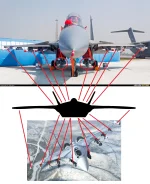India's AMCA to Gain Air Superiority with LPI Technology
India's pursuit of a cutting-edge, domestically developed fighter jet is taking a significant leap forward with the Advanced Medium Combat Aircraft (AMCA) program.
A central focus in the AMCA's design is the integration of advanced Low Probability of Intercept (LPI) radar technology – a hallmark of modern stealth aircraft designed to minimize their electronic footprint.
The LPI Advantage
LPI radars operate by emitting radio frequency (RF) signals in a manner that makes them incredibly difficult for traditional radar systems to detect.
This is achieved through a combination of techniques, such as using specialized waveforms, spreading signal emissions across a wide frequency range, and carefully controlling signal power.
The AMCA's stealth capabilities don't end there. The aircraft's physical design plays a vital role, too. Engineers carefully shape the aircraft with specific angles and
use materials designed to deflect radar waves away from their source.
Additionally, special coatings on the aircraft's surface help to absorb incoming radar energy, significantly reducing its radar cross-section (RCS).
The Importance of Stealth in Modern Warfare
By minimizing its radar signature, the AMCA gains a crucial advantage in aerial combat. It will be able to penetrate contested airspace with a lower risk of detection, allowing it to conduct surprise strikes or gather intelligence without alerting the enemy.
This reduced detectability also enhances the AMCA's survivability by making it more difficult for enemy radars to track and target the aircraft.
The Challenges and Future of LPI Technology
While LPI technology offers clear advantages, it's important to understand its limitations. True invisibility is unachievable, as any radar system, no matter how stealthy, must emit some level of signal in order to function. The ongoing challenge lies in striking the right balance between minimizing those emissions while still allowing the radar to perform its essential tasks.
Furthermore, as radar detection technology continues to evolve, LPI systems must also adapt to remain effective. India's commitment to sustained research and development in this field will be key to maintaining the AMCA's technological edge in the years to come.
India's Pursuit of Self-Reliance
The AMCA program, and its focus on advanced technologies like LPI radar, represents a bold statement in India's drive for self-reliance in critical defence sectors.
The successful development of a homegrown 5th-generation fighter jet with potent stealth capabilities would serve as a testament to the nation's growing technological prowess.

